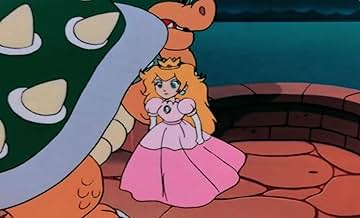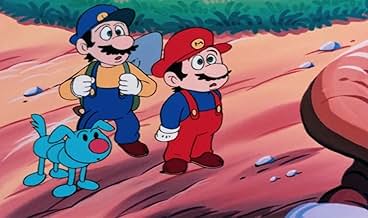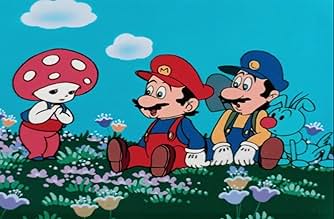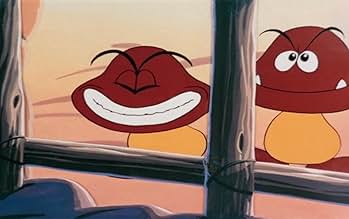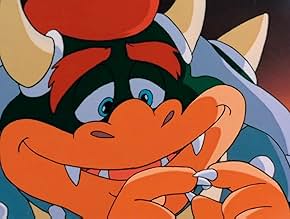Super Mario Bros. : La Grande Mission pour sauver la princesse Peach !
Original title: Sûpâ Mario burazâzu: Pîchi-hime kyushutsu dai sakusen!
IMDb RATING
5.7/10
633
YOUR RATING
The Mario Bros.Mario and Luigi go to another dimension, and must now rescue Princess Peach from King Bowser Koopa.The Mario Bros.Mario and Luigi go to another dimension, and must now rescue Princess Peach from King Bowser Koopa.The Mario Bros.Mario and Luigi go to another dimension, and must now rescue Princess Peach from King Bowser Koopa.
- Director
- Writers
- Stars
Tôru Furuya
- Mario
- (voice)
Yû Mizushima
- Luigi
- (voice)
Junko Hori
- Jugem (Lakitu)
- (voice)
- …
Masami Kikuchi
- Prince Haru
- (voice)
Keaton Yamada
- Hammer Bros.
- (voice)
Hiroko Emori
- Kinopio (Toad) B
- (voice)
Maki Itô
- Patapata no Kodomo (Child Paratroopa)
- (voice)
- (as Berîzu)
Chiemi Matsumoto
- Patapata no Kodomo (Child Paratroopa)
- (voice)
- (as Berîzu)
Hiromi Ônishi
- Patapata no Kodomo (Child Paratroopa)
- (voice)
- (as Berîzu)
Jôji Yanami
- Priest
- (voice)
- Director
- Writers
- All cast & crew
- Production, box office & more at IMDbPro
Featured reviews
I never heard of this anime movie until the internet, as this was ultra rare, and was never released in America (in fact, this was never re-released in Japan in any form). Made a year after the original Super Mario Bros. game was released, the anime movie sees Mario and Luigi as grocery store owners. One night, Mario meets Peach while playing video games late at night, where Koopa beats him and captures her, leaving her necklace. After a dog grabs it, the two chase it into a pipe, leading them into the Mushroom Kingdom, where they are tasked to stop Koopa, who is king of the Metal Kingdom, and save Peach from marriage, while also collecting the three powers needed to stop Bowser.
As this was made a year after the original Super Mario Bros. game was released, continuity was not established, so there are a lot of things that are different from the Mario lore we know today (Luigi is wearing blue overalls over a yellow shirt, and is greedy, a trait people know Wario better for having, and the film has some characters exclusive to it, like Kibidango the dog, and a Toadette that predates the official one), this is a okay, if not weird Mario anime movie. The main thing I like about it is the soundtrack, as it not only has music from the video game, but also the neat song "Doki-Doki Do It".
As this was made a year after the original Super Mario Bros. game was released, continuity was not established, so there are a lot of things that are different from the Mario lore we know today (Luigi is wearing blue overalls over a yellow shirt, and is greedy, a trait people know Wario better for having, and the film has some characters exclusive to it, like Kibidango the dog, and a Toadette that predates the official one), this is a okay, if not weird Mario anime movie. The main thing I like about it is the soundtrack, as it not only has music from the video game, but also the neat song "Doki-Doki Do It".
While the 1993 Mario Bros movie has garnered a cult fanbase and the upcoming Illumination movie has drawn polarizing feedback, another Mario movie remains in obscurity. Released in 1986, one year after the original Super Mario Bros NES game, Nintendo and Shochiku presented a feature length Japanese animated movie entitled Super Mario Bros: The Great Mission to Rescue Princess Peach. Despite never having an official international release outside of the internet, the film has often been regarded as a personal favorite in the Mario community. So being the first ever movie based on a video game, how does it hold up today?
The main story centers on Mario and Luigi, who embark on an alternate dimensional quest to save Princess Peach from the villainous King Koopa. As cliche as that premise sounds, it's all that is needed for an adventure like this, since the original video game was a straightforward rescue journey to save a hostage princess. Similarly to the original game as well, the obstacles that Mario and Luigi face along their journey range from frightening monsters to surrealistic landscapes, commonplace in all sorts of hero journeys. The film opts for a more lighthearted comedic tone to fit with the video game's upbeat gameplay, even in lieu of the occasional dramatic obstacle or scary opponent. It does work in its favor for the most part, although some scenes do drag to the point of losing focus from the main plot. The film is usually at its most emotionally resonative whenever it revolves around Mario mourning over Peach, and even those moments are often leftover for the brother's crazy foes and chapters along their way. It's a good thing the story feels like a video game, if not for detracting reasons.
In terms of other notable qualities, the animation direction of Masami Hata goes in a more cartoony format reminiscent of 40s Western cartoons, which also works for the comedic hijinks that ensue on Mario and Luigi's quest. This direction also suits Luigi's hammy persona that contrasts with his greed, not unlike many of the original Looney Tunes shorts. Perhaps the most creative of all visual spectacle in the film would have to be the many worlds throughout our hero's journey, varying in dynamic colors, set pieces and imaginative landscapes. The animators, layout artists and background painters managed to bring creatures from the original game into animation by distinguishing their appearances just enough to work on their own. As for the voice cast, they manage to bring their own spin to the characters through emotive performances, especially Akiko Wada as the diluted King Koopa. It's still bizarre that this never had a proper English release, because one would imagine the game's huge popularity would have made that inevitable. That being said, subtitles never hurt.
As a film adaptation of the original Mario Bros game, this feature works just enough on its own for what it's going for. It might not work as an introduction to newcomers due to its heavily specific plotline, but for Mario fans, it's a solid tribute to the games with just enough wacky obstacles and fun animation to go around. I would recommend this with a grain of salt due to its limited availability and general appeal remaining amongst a niche audience. Thanks to a lot of hard work from fans and historians, the film could get even more attention than ever before.
The main story centers on Mario and Luigi, who embark on an alternate dimensional quest to save Princess Peach from the villainous King Koopa. As cliche as that premise sounds, it's all that is needed for an adventure like this, since the original video game was a straightforward rescue journey to save a hostage princess. Similarly to the original game as well, the obstacles that Mario and Luigi face along their journey range from frightening monsters to surrealistic landscapes, commonplace in all sorts of hero journeys. The film opts for a more lighthearted comedic tone to fit with the video game's upbeat gameplay, even in lieu of the occasional dramatic obstacle or scary opponent. It does work in its favor for the most part, although some scenes do drag to the point of losing focus from the main plot. The film is usually at its most emotionally resonative whenever it revolves around Mario mourning over Peach, and even those moments are often leftover for the brother's crazy foes and chapters along their way. It's a good thing the story feels like a video game, if not for detracting reasons.
In terms of other notable qualities, the animation direction of Masami Hata goes in a more cartoony format reminiscent of 40s Western cartoons, which also works for the comedic hijinks that ensue on Mario and Luigi's quest. This direction also suits Luigi's hammy persona that contrasts with his greed, not unlike many of the original Looney Tunes shorts. Perhaps the most creative of all visual spectacle in the film would have to be the many worlds throughout our hero's journey, varying in dynamic colors, set pieces and imaginative landscapes. The animators, layout artists and background painters managed to bring creatures from the original game into animation by distinguishing their appearances just enough to work on their own. As for the voice cast, they manage to bring their own spin to the characters through emotive performances, especially Akiko Wada as the diluted King Koopa. It's still bizarre that this never had a proper English release, because one would imagine the game's huge popularity would have made that inevitable. That being said, subtitles never hurt.
As a film adaptation of the original Mario Bros game, this feature works just enough on its own for what it's going for. It might not work as an introduction to newcomers due to its heavily specific plotline, but for Mario fans, it's a solid tribute to the games with just enough wacky obstacles and fun animation to go around. I would recommend this with a grain of salt due to its limited availability and general appeal remaining amongst a niche audience. Thanks to a lot of hard work from fans and historians, the film could get even more attention than ever before.
English: Such a cute movie! I remember the first time I heard about this is was in a Princess Peach evolution video then I saw it again on a clip and I'm surprised my dad hasn't heard of this because he basically was born during Mario's timeline but every time I see this I'm like "This is so cute!" And I can't watch it in the English dub because it's just not my childhood, my childhood is the Japanese one with the English Subtitles, It's such a cute movie!
10chribren
"Super Mario Bros: The Great Mission to Save Princess Peach" is a children-oriented anime film made in 1986. It was directed by Masami Hata who also made stuff like "Ringing Bell" and "The Legend of Sirius".
However, this film is pretty hard to find. It was only released in Japan at the time it was made. It has not been released in the US at once, making this anime ultra-rare.
Short about the beginning: The film begins with Mario playing some video game, until the beautiful Princess Peach suddenly pops out of the TV, only to be kidnapped by Bowser in front of Mario's eyes. So it's later up to the Mario brothers to save her.
The film stays very true to the Mushroom Kingdom (Princess Peach's famous home-place), as well as the iconic save-the-princess-plot. The popular enemies like Goombas (Kuribo) and Lakitu (Jugem) are also portrayed well. The only things which bugged me a little bit is the fact Luigi is wearing yellow, not green as he usually does. The characters generally are much better drawn than they were in the US cartoon version made by DIC. And Princess Peach is just so CUTE in this film, compared to how she was in the later cartoon series as Princess Toadstool. These are the reasons for me saying this anime being a lot better than the US cartoon series "The Super Mario Bros. Super Show!" made by DIC three years later.
It was also interesting to know that Mami Yamase, who voiced as Princess Peach, also sung the touching closing song "I Love You".
As I said first in this review, this film is pretty hard to find as it was only released in Japan in 1986. Even in its homeland Japan this anime is a hard find. If you ever get to find this film, then you are lucky. ;-)
However, this film is pretty hard to find. It was only released in Japan at the time it was made. It has not been released in the US at once, making this anime ultra-rare.
Short about the beginning: The film begins with Mario playing some video game, until the beautiful Princess Peach suddenly pops out of the TV, only to be kidnapped by Bowser in front of Mario's eyes. So it's later up to the Mario brothers to save her.
The film stays very true to the Mushroom Kingdom (Princess Peach's famous home-place), as well as the iconic save-the-princess-plot. The popular enemies like Goombas (Kuribo) and Lakitu (Jugem) are also portrayed well. The only things which bugged me a little bit is the fact Luigi is wearing yellow, not green as he usually does. The characters generally are much better drawn than they were in the US cartoon version made by DIC. And Princess Peach is just so CUTE in this film, compared to how she was in the later cartoon series as Princess Toadstool. These are the reasons for me saying this anime being a lot better than the US cartoon series "The Super Mario Bros. Super Show!" made by DIC three years later.
It was also interesting to know that Mami Yamase, who voiced as Princess Peach, also sung the touching closing song "I Love You".
As I said first in this review, this film is pretty hard to find as it was only released in Japan in 1986. Even in its homeland Japan this anime is a hard find. If you ever get to find this film, then you are lucky. ;-)
This is the oldest animated Super Mario Bros. Cartoon. And it contains all the elements from the game. The plot is similar to with the whole Mario Bros. travel in Mushroom Kingdom to save Princess Peach from Bowser. Only the story is different.
There are minor and secondary characters entirely original for this movie only. Plus it has a few changes like Luigi wearing yellow instead of green, & the Mario Bros. are grocery store owners and not plumbers.
Despite all that the movie has a good flow to it as well as some pretty catchy Japanese voice talent. But for only 60 minutes long, there's so much more they could include in this movie.
Sadly this is the only existing Mario Bros. anime. And I think it wouldn't hurt to make another one that's done with newer animation. I mean if Pokemon can have a successful anime. Why not the Mario Bros, there's so much value that can make a highly interesting based off of a video game anime.
I didn't see this movie till most recently. And it's never been released outside of Japan at all. An English dub is out of the question as very few anime distribution companies would never dub anything this old and out of date animation.
The only way it would ever be released is to get it on a sub-only DVD and get permission by Nintendo in doing so.
There are minor and secondary characters entirely original for this movie only. Plus it has a few changes like Luigi wearing yellow instead of green, & the Mario Bros. are grocery store owners and not plumbers.
Despite all that the movie has a good flow to it as well as some pretty catchy Japanese voice talent. But for only 60 minutes long, there's so much more they could include in this movie.
Sadly this is the only existing Mario Bros. anime. And I think it wouldn't hurt to make another one that's done with newer animation. I mean if Pokemon can have a successful anime. Why not the Mario Bros, there's so much value that can make a highly interesting based off of a video game anime.
I didn't see this movie till most recently. And it's never been released outside of Japan at all. An English dub is out of the question as very few anime distribution companies would never dub anything this old and out of date animation.
The only way it would ever be released is to get it on a sub-only DVD and get permission by Nintendo in doing so.
Did you know
- TriviaThe voice of Bowser Koopa was actually provided by a woman, Akiko Wada, a famous singer from Japan.
- GoofsLuigi's overalls on the VHS cover do not match the ones he wears throughout the film.
- Quotes
Princess Peach Toadstool: Ah, please come rescue me, Mario. Please!
- Crazy creditsBehind the credits, Mario and Luigi are shown leaving the Mushroom Kingdom and heading home.
- ConnectionsFeatured in Cinematic Excrement: Super Mario Bros. (2014)
- SoundtracksDoki-doki Do It! ~Bishitto-bashitto Rock'n Roll Gakkô-hen~
Music by Toshiyuki Kimori
Lyrics by Mari Hayama
Performed by Mirai Dôji
Arranged by Toshiyuki Kimori
Details
- Release date
- Country of origin
- Language
- Also known as
- Super Mario Brothers: Great Mission to Rescue Princess Peach
- Production companies
- See more company credits at IMDbPro
- Runtime
- 1h(60 min)
- Color
Contribute to this page
Suggest an edit or add missing content

